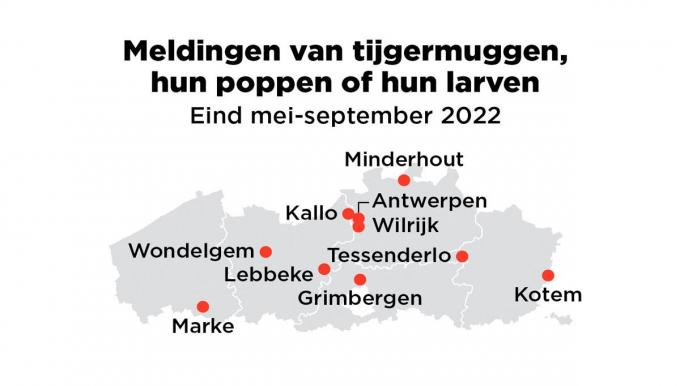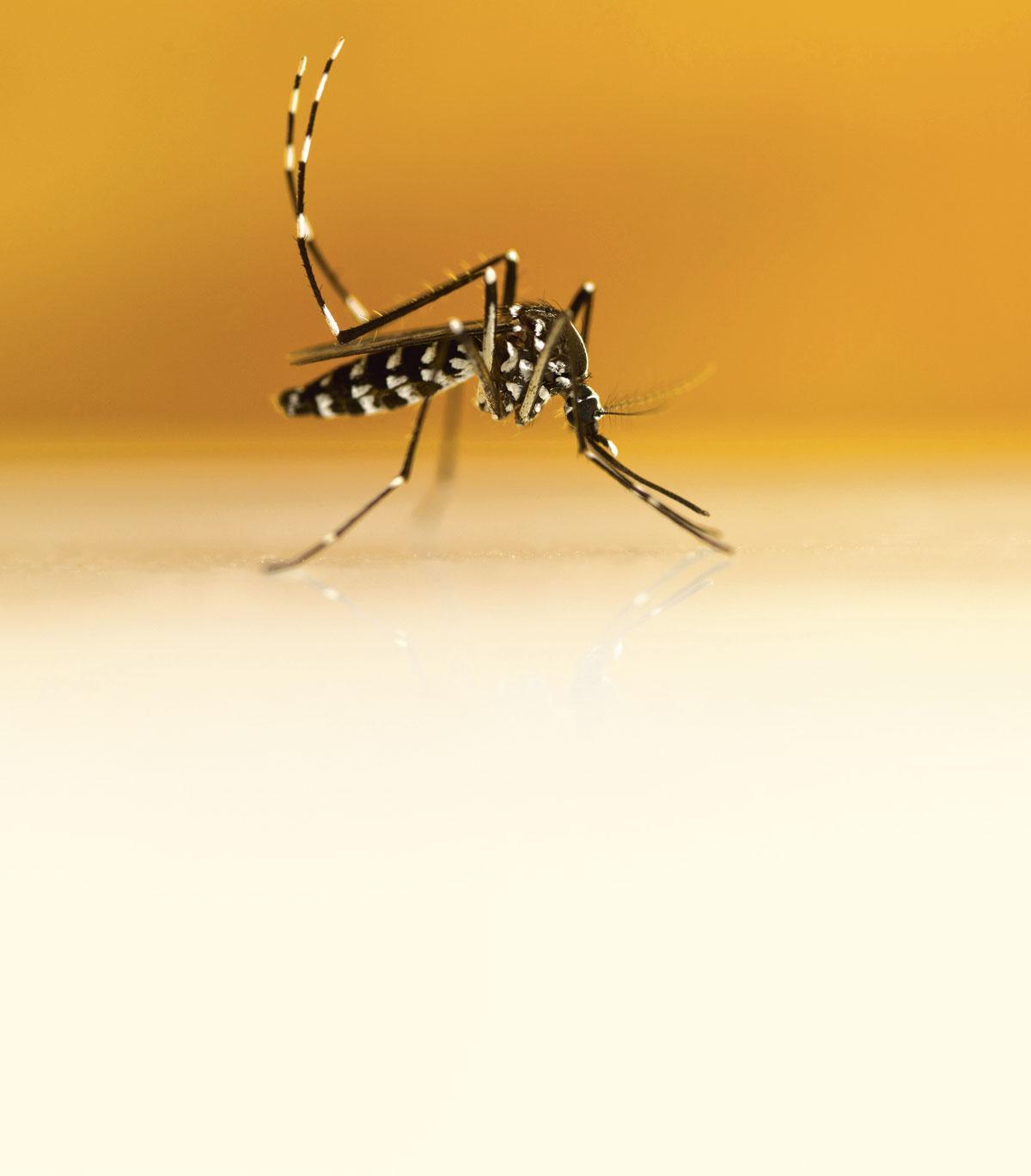Tiger mosquitoes, including larvae and pupae, have been found in several places in recent weeks. The dangerous mosquito, which spreads tropical fevers, is gradually establishing itself in our country.
In early August, someone in his garden in Lebbeke, East Flanders, found a mosquito that suspiciously resembled a tiger mosquito: rather small and dark with white stripes on the body and limbs. He posted a photo of the animal on the website www.muggensurveillance.be. It is a “platform for citizens to monitor and report the tiger mosquito in Belgium”, created by the Institute of Tropical Medicine (ITM) and the Federal Institute of Public Health Sciensano. After the evaluation it turned out to be a tiger mosquito.
On August 18, the ITM researchers went to the site and investigated the situation within a 500-meter radius around the site. They found “large numbers” of mosquitoes, both larvae and pupae and adult males and females. It is the first time that there is talk of a possible ‘settlement’ of this species in our country. The animals underlying the population were probably brought in a wagon from Italy in July, where the tiger mosquito is already well established.

In recent weeks, confirmed observations have also been made from the Antwerp area through the same site: from the city of Antwerp, from a tire company in Kallo and from Wilrijk – in the last location, larvae and pupae were also found at the beginning. of September. Reports came from Grimbergen on the outskirts of Brussels, Wondelgem near Ghent and Kotem in the Meuse valley. Further mosquito sightings are already underway in Wallonia, mainly through active monitoring with mosquito traps in parking lots along motorways from the south.
Analysts find it disturbing that so many Flemish observations are made by citizens. ITM’s “active” surveillance catches fewer mosquitoes. It mainly focuses on places with a higher risk of tiger mosquito introduction, such as tire centers and garden centers. Tiger mosquitoes are easily spread through eggs in small amounts of water, which remain in car tires and flower pots, containing mainly ornamental bamboo plants.
Embargo for the press and the public
It is surprising that there is little fuss over the recent finds. After each discovery, the experts involved receive a message with the message “CONFIDENTIAL: embargo for the press and the general public”. However, it is advisable to map the presence of the Asian tiger mosquito as completely as possible, as it spreads tropical viruses that cause fevers such as dengue, west nile, zika and chikungunya. New insights suggest that it also transmits yellow fever. Like our local mosquitoes, female tiger mosquitoes need blood to develop their eggs. This allows them to suck up viruses and transfer them to other victims.
Dengue fever has already been observed in Croatia, France, Italy and Spain and is said to have caused six deaths in Europe this year. At the end of August, 442 cases of West Nile virus have been identified in eastern and southern Europe, resulting in at least 20 deaths, mainly in Italy and Greece. Chikungunya and Zika also arrived in Europe and were picked up in southern France, among other places. So it is no longer just mosquitoes, but also viruses that are heading towards us.
Mosquitoes are benefiting from globalization, which moves people and goods around the world, and from global warming, which makes conditions more suitable for their survival. Their ideal life temperature is between 20 and 25 degrees Celsius, and if it doesn’t drop below 3 degrees in winter, they stay alive.
Employees of the Flemish Institute for Technological Research (VITO) mapped the anticipated distribution of the tiger mosquito in Europe, under circumstances that have been described as ‘business as usual’: no substantial change in the fight against both global warming and the mosquito. The results have been disappointing, especially for our region: by the end of the century much of Belgium, the Netherlands and northern France will be ideal for the survival of the tiger mosquito. Currently, the populations closest to us are located near the French cities of Paris and Strasbourg.
Flemish experts express great concern about the situation, especially since the gravity of the situation does not seem to reach the authorities. Ten years ago, an inter-cabinet working group was called upon to monitor and control, under the motto: every year being able to stop the tiger mosquito means a gain for public health. A monitoring program has been initiated and is being implemented by ITM.
The intention was for monitoring to be resumed after about four years by a new institute that was to step up the fight against dangerous mosquitoes, following the model of the Dutch Center for Active Vector Monitoring. But it never happened. Monitoring by the ITM has been extended each time, but it is too limited to track all tiger mosquito populations. The laxity is partly a consequence of the complexity of our state structures, with competences divided between the federal and regional levels. Nobody really pulls the cart.
Read more below the illustration.


Empty bottle caps
Dutch mosquito fighters express their dissatisfaction with the Belgian approach to the interior, because if the mosquito takes hold in our home, the chance of it falling on them increases. Whenever a tiger mosquito is found in the Netherlands, important resources are launched to scour the entire neighborhood around the find and inform residents of what they can do to eliminate the mosquitoes. This mainly concerns the sealing of water puddles in the home and garden, such as in gutters and flower pots. Even empty bottle caps can hold enough water for the mosquito to breed.
With us, the resources available are too limited to perform such actions consistently for all exhibits. There are also too few resources to carry out active monitoring in a sufficiently intense way. However, the cost of efficient monitoring is minimal compared to what it would cost to public health if the tiger mosquito settled permanently in our region.
In addition, mosquitoes are monitored, but it is not checked whether they are carriers of pathogenic viruses. The chance that this is small, but not zero. For example, in the past two years, four people have been affected by malaria near Zaventem airport, caused by a single-celled parasite also transmitted by mosquitoes. Two victims did not survive. These were people who had not traveled and therefore probably had been infected with a mosquito that had hitched a ride on a plane.
A recent report in the newspaper Climate change of nature concluded that no less than 58 percent of the world’s infectious diseases are on the rise due to climate change. The number of cases of dengue fever has tripled in half a century. So the warnings about the spread of the tiger mosquito are not counterproductive panic messages. They show the harsh reality.
–


